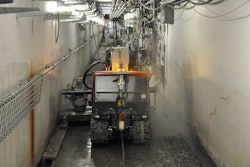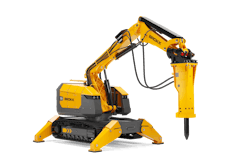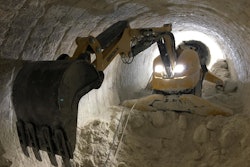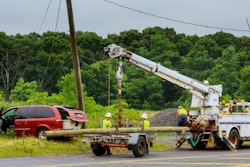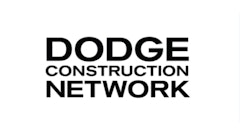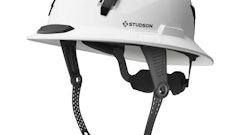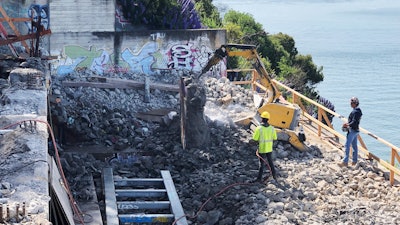
Demolition can be a dangerous job. Whether it’s road and bridge repair, interior demolition or any other application that requires crews to dismantle existing construction, creating a culture of safety is vital for protecting workers and maintaining overall efficiency.
For some contractors, remote-controlled demolition machines have become an important part of that culture. These machines allow operators to stand a safe distance from active demolition, reducing the risk of injury from flying or falling debris. Additionally, demolition robots can operate in dangerous or extreme environments that would require special equipment and added risk for workers.
While demolition robots can provide peace of mind for contractors and crews, like any machine, overall safety depends on operator diligence. Thorough training with equipment experts as well as frequent in-house review of safety procedures are necessary for keeping safety top of mind.
Here are five simple safety tips operators should remember when using remote-controlled demolition equipment.  Operators should maintain a clear view of the machine, the power supply and cables and the work area at all times during use. On jobsites crowded with traffic or visual obstacles, designating a spotter can also help increase safety.Brokk Inc.
Operators should maintain a clear view of the machine, the power supply and cables and the work area at all times during use. On jobsites crowded with traffic or visual obstacles, designating a spotter can also help increase safety.Brokk Inc.
- Keep Your Eyes Open: Operators should maintain a clear view of the machine, the power supply and cables and the work area at all times during use. It’s impossible to keep track of everyone on the jobsite, but the operator must take responsibility for keeping site personnel safely out of the risk zone while the remote-controlled demolition machine is in operation. On jobsites crowded with traffic or visual obstacles, it can be difficult for one person to keep track of the risk zone. In these situations, designating a spotter can help.
- Stay at Arm’s Length: When using remote-controlled demolition equipment, the size of the risk zone is based on many factors—such as the work object, work method, surface, position of the arm, angle of machine and operator—and is constantly in flux. Maintain a safe jobsite by keeping everyone outside the robot’s arm’s length while in operation. If the operator or another crew member needs to enter the risk zone, be sure the machine is in emergency stop mode or de-energized and cannot be moved accidentally. And always ensure the machine is off when not in use.
- Inspect Each Day: Remote-controlled demolition machines are manufactured to take a beating, but that doesn’t mean operators should forego daily maintenance and inspections. Even slight damage can lead to increased safety risks. Before operation, visually inspect the machine — paying close attention to fluid levels and hoses — and make sure everything is properly lubricated. Always check that the power cable and connector are undamaged before plugging in, as well. For more information on daily maintenance for your machine, consult the operator’s manual or contact the manufacturer.
- Watch for Overhead Dangers: When working or maneuvering in certain conditions, there is an increased risk of falling objects or tipping the machine. To avoid these, be sure that everyone is outside the risk zone; the outriggers are fully deployed and the machine is level; and no one is beneath the work object or a raised arm, even if the machine is off.
- Protect Yourself: It’s no secret, personal protection equipment (PPE) should be worn at all times. The exact PPE, however, might vary based on the job at hand, and might include:
- Safety harnesses and stands when working at height
- Breathing masks, gas masks or airstream helmets for sites with harmful air
- Heat shields and appropriate protective clothing for hot environments
- Barriers to define risk zone
- Safety equipment to secure machine components during repair and service
When it comes to safe, efficient operation of remote-controlled demolition machines, these tips are the bare minimum. Working with equipment manufacturers for ongoing training is a great way to ensure new and experienced operators are provided the best equipment-specific training. Industry-leading OEMs offer a number of training curriculum—including on-site, hands-on options—making it easy to arrange learning opportunities for fluctuating crews. But perhaps the best way to keep crews safe and prevent problems is also one of the easiest—frequently reviewing safety protocols with team members and keeping eyes and ears open on the jobsite.
About the author
Jeff Keeling is the vice president of sales & marketing for Brokk Inc. and serves on the board for the Concrete Sawing and Drilling Association. He works closely with regional sales managers to develop and grow the Brokk brand in key segments across the United States and Canada. He is also responsible for educational initiatives aimed at helping customers maximize their Brokk machines’ potential.




